Inflammatory Cells: Key Players in Disease and Healing
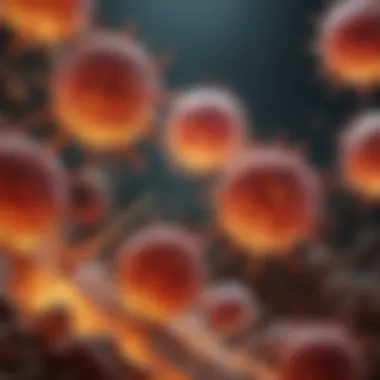
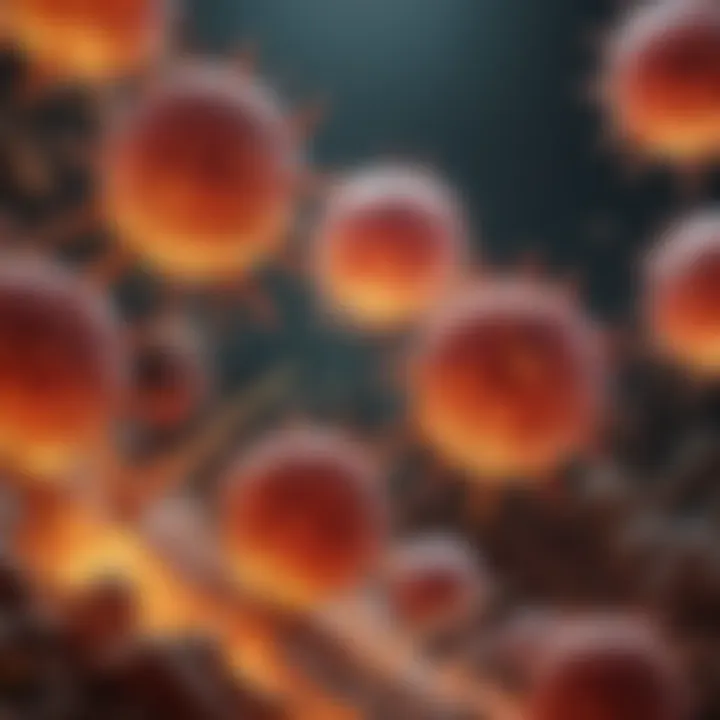
Intro
Inflammation is a biological response that occurs as a result of infection, injury, or any form of stress to the body. At the core of this response are inflammatory cells, which play pivotal roles in both disease pathogenesis and the subsequent repair processes. Understanding these cells is crucial for comprehending various health conditions and developing effective treatments.
Inflammatory cells include a range of white blood cells such as neutrophils, macrophages, mast cells, dendritic cells, and lymphocytes. Each type contributes uniquely to immune responses. They orchestrate the delicate balance between protecting the body from pathogens and facilitating tissue repair after injury, as well as inadvertently contributing to chronic diseases.
Research Overview
Methodological Approaches
Research into the role of inflammatory cells employs various methodologies. These include in vitro and in vivo studies, advanced imaging techniques to observe cell behavior in real time, and genetic sequencing to understand signaling pathways. Techniques such as flow cytometry allow for the detailed characterization of cell populations and their functions in various conditions.
Other approaches involve the use of animal models to study specific diseases linked to inflammation. These models provide insights on how inflammatory cells contribute to pathogenesis and repair. Furthermore, patient samples and clinical data are invaluable for translating findings into applicable therapeutic strategies, emphasizing the relevance of inflammatory cell study in real-world health issues.
Significance and Implications
The implications of this research extend across multiple domains. By exploring how inflammatory cells operate, we gain insights into conditions like autoimmune diseases, allergies, and chronic infections. Moreover, understanding their role in tissue repair can lead to better strategies for managing wound healing, organ transplant rejection, and other repair processes.
Researchers can ultimately devise targeted therapies that modulate inflammation for improved outcomes in various diseases. The dual nature of inflammatory cells as both protectors and potential instigators of disease makes this area of study particularly significant.
Current Trends in Science
Innovative Techniques and Tools
Recent advancements in science have introduced innovative tools to study inflammatory cells. Techniques like single-cell RNA sequencing allow scientists to identify diverse cell populations and their functional states. This precision can lead to targeted treatment options.
Additionally, multiplex assays enable the detection of multiple cytokines and chemokines simultaneously, providing a comprehensive view of inflammatory responses in different disease states.
Interdisciplinary Connections
The study of inflammatory cells is inherently multidisciplinary. Connections with immunology, molecular biology, and even bioinformatics enrich our understanding of inflammatory processes. Collaborative research initiatives draw on expertise from various fields, which can lead to holistic approaches in understanding diseases linked to inflammation and repairing tissue damage.
"Inflammatory cells stand at the intersection of the immune system and disease. Understanding their roles can reveal crucial insights for better health outcomes."
Foreword to Inflammatory Cells
Inflammatory cells play a crucial role in initiating and regulating responses to injury and infection. Understanding these cells is foundational to grasping the broader context of inflammation and its impact on health and disease. This section elucidates the types of inflammatory cells, their functions, and their significance in both physiological and pathological states.
Definition of Inflammatory Cells
Inflammatory cells are specialized immune cells that participate in the body's response to harmful stimuli. These cells include neutrophils, macrophages, lymphocytes, mast cells, eosinophils, and basophils. Each type serves distinct roles, from immediate responses to pathogens to orchestration of the healing process. Their ability to migrate to sites of injury or infection is essential for containing damage and initiating tissue repair.
Importance of Inflammation in Physiology
Inflammation is a complex biological process. It may appear harmful, especially in chronic scenarios, but it is primarily protective. The acute inflammatory response helps eliminate pathogens and initiates tissue repair. Key events in inflammation include vasodilation, increased vascular permeability, and leukocyte recruitment. Such processes allow for adequate immune surveillance and rapid healing.
"Inflammation is not merely a response; it is a decisive factor in recovery and resilience to stressors."
Moreover, inflammatory cells release various mediators that influence other cells and tissues, thus playing a vital role in homeostasis. Maintaining a balance between these processes is essential to preventing excessive inflammation, which can lead to various diseases, including autoimmune disorders and chronic inflammatory conditions.
Types of Inflammatory Cells
Understanding the types of inflammatory cells is crucial in grasping their roles in health and disease. Each cell type has distinct functions and characteristics that contribute to the immune response and tissue repair processes. By exploring these various cells, we can better appreciate how the immune system effectively battles infections, responds to injuries, and sometimes plays a role in pathological conditions.
Neutrophils
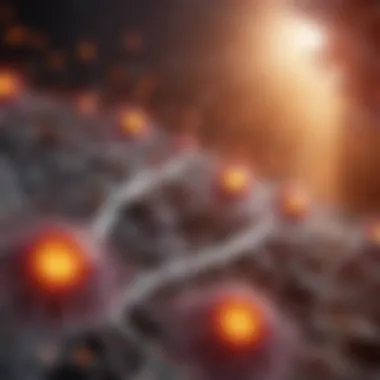

Neutrophils are the most abundant type of white blood cells in the human body. They account for approximately 50-70% of all circulating leukocytes. These cells are the first responders to sites of infection or injury. Neutrophils act quickly, arriving at the scene within minutes. Their primary role is to engulf and destroy pathogens through phagocytosis. In addition, they release enzymes and reactive oxygen species that help eliminate bacteria.
However, while neutrophils are essential for defense, their overactivation can lead to tissue damage. Excessive neutrophil activity is implicated in various inflammatory diseases, such as rheumatoid arthritis and chronic obstructive pulmonary disease. Understanding the balance between neutrophil activity and regulation is critical for developing therapeutic strategies.
Macrophages
Macrophages are versatile cells that arise from monocytes. They play a vital role in both the initiation and resolution of inflammation. Macrophages can differentiate into various functional states, including pro-inflammatory (M1) and anti-inflammatory (M2) types. M1 macrophages are effective in killing pathogens, while M2 macrophages are involved in tissue repair and anti-inflammatory responses.
These cells also present antigens to lymphocytes, promoting adaptive immune responses. Their ability to clear dead cells and debris is fundamental in wound healing processes. Moreover, dysregulation of macrophage function is linked to diseases such as atherosclerosis and obesity-induced inflammation.
Lymphocytes
Lymphocytes consist of different subtypes, notably B cells and T cells. B cells are responsible for producing antibodies that target specific antigens. They are crucial in the adaptive immune response, ensuring long-lasting immunity against pathogens. T cells, including helper T cells and cytotoxic T cells, have various roles in orchestrating immune responses and directly killing infected cells.
Lymphocytes can also contribute to chronic inflammation in autoimmune disorders. For example, in systemic lupus erythematosus, autoreactive lymphocytes target normal tissues. Understanding lymphocyte functions aids in comprehending the complexities of immune regulation and disease.
Mast Cells
Mast cells are found in tissues and play a crucial role in allergic responses and defense against parasites. They are rich in granules containing histamine and other mediators. Upon activation, mast cells release these substances, leading to increased blood flow and recruitment of additional inflammatory cells to the site of injury or infection.
While mast cells are vital for initiating localized inflammation, their overly aggressive responses can contribute to allergic reactions, such as asthma and anaphylaxis. Thus, balancing mast cell activity is essential to prevent excessive tissue damage and maintain proper immune responses.
Eosinophils
Eosinophils primarily combat parasitic infections and are also involved in allergic reactions. They contain granules filled with toxic proteins that damage parasites. In addition, eosinophils release cytokines and chemokines, influencing the activity of other immune cells.
However, it is worth noting that during allergic responses, eosinophils can become activated excessively. Such dysregulation is often observed in conditions like asthma, contributing to chronic inflammation of the airways.
Basophils
Basophils are the least common type of white blood cells. Similar to mast cells, basophils release histamine and other mediators during inflammatory responses. They play a role in modulating the immune response, particularly in allergic reactions. Basophils can also contribute to the defense against parasitic infections. However, their exact roles in various pathologies remain an area of ongoing research, especially in relation to chronic inflammatory diseases.
In summary, each type of inflammatory cell serves specific functions, and their interactions are crucial for a properly functioning immune system. Understanding these cells aids in developing targeted therapies for various conditions, including allergies, infections, and autoimmune diseases.
Activation of Inflammatory Cells
The activation of inflammatory cells is a critical focal point in understanding how the immune system responds to various stimuli, particularly in the context of disease and healing. This process not only determines the magnitude and duration of inflammation but also influences the outcome of tissue repair. By discussing the mechanisms of activation, we can better appreciate the dual role these cells play in pathogenesis and recovery.
Recognition of Pathogens
Inflammatory cells, such as macrophages and neutrophils, are adept at recognizing pathogens through surface receptors. One of the key aspects of their activation is the recognition of pathogen-associated molecular patterns (PAMPs). These are unique molecules found on microbes and not on host cells. Upon recognition, cells undergo a series of changes that set off inflammatory responses.
Furthermore, pattern recognition receptors (PRRs), including Toll-like receptors (TLRs), play a crucial role in this recognition process. These receptors help initiate signaling cascades that result in the production of pro-inflammatory cytokines. Cytokines serve as critical messengers that attract more immune cells to the site of infection or injury. This early response is vital for containing pathogens and averting widespread tissue damage.
Cytokine Signaling
Cytokine signaling uniquely coordinates the inflammatory response. Once inflammatory cells recognize a stimulus, they release cytokines that interact with their receptors on other cells, amplifying the response. For example, Interleukin-1 (IL-1) and Tumor Necrosis Factor-alpha (TNF-α) are potent pro-inflammatory cytokines that promote inflammation and recruit more cells.
In addition to pro-inflammatory cytokines, anti-inflammatory cytokines, like IL-10, are produced to control the duration and intensity of the inflammatory response. This balance is crucial; inadequate signaling can lead to persistent inflammation, while excessive signaling can result in tissue damage. Understanding these signaling pathways helps in developing therapeutic strategies that modulate inflammation effectively.
Cellular Responses to Injury
Once inflammatory cells are activated and have recognized a pathogen or injury, they execute a range of responses aimed at restoring tissue homeostasis. Neutrophils, for example, are among the first responders, rapidly migrating to the site of injury or infection through chemotaxis, which is directed by cytokines and chemokines.
Upon arrival, these cells can phagocytose pathogens, which is the process of engulfing and degrading them. Besides this, they release various enzymes and reactive oxygen species that can destroy pathogens. However, these responses also carry risks. If not properly controlled, they can lead to collateral tissue damage, emphasizing the importance of regulatory mechanisms.
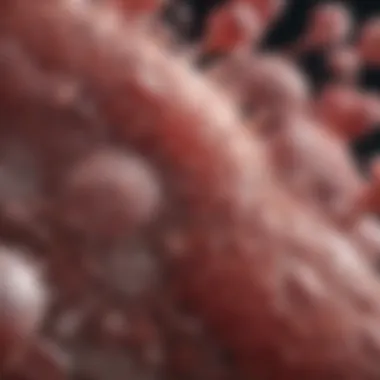

The intricacy of inflammatory cell activation underlines their pivotal role in health and disease, shaping therapeutic approaches aimed at enhancing recovery while mitigating tissue injury.
Inflammatory Mediators
Inflammatory mediators play an essential role in the complex interplay of immune responses. These substances, which include cytokines, chemokines, and other signaling molecules, are pivotal for directing inflammatory processes. They help to manage the body's response to injury and infection, influencing cell metabolism, proliferation, and interaction. Understanding these mediators is crucial for grasping their contribution to both disease and repair. The balance between pro-inflammatory and anti-inflammatory mediators determines the outcome of inflammation. An imbalance can lead to chronic inflammation or unresolved tissue injury, stressing the importance of studying these mediators.
Types of Inflammatory Mediators
Inflammatory mediators can be classified into several categories, each with unique roles:
- Cytokines: These are small proteins released by cells that have a specific effect on the interactions and communications between cells. Examples include interleukins, interferons, and tumor necrosis factor (TNF).
- Chemokines: A subset of cytokines, chemokines are involved specifically in the chemotaxis of immune cells to sites of inflammation.
- Prostaglandins: These are lipid compounds that have various hormone-like effects, including the modulation of inflammation, pain, and fever.
- Leukotrienes: These are also lipid mediators that primarily contribute to the inflammatory response, particularly in asthma and allergic reactions.
- Histamines: Stored in mast cells, histamines play a vital role in allergic responses and are released upon tissue injury or allergen exposure.
Role of Chemokines
Chemokines are critical in orchestrating the migration of leukocytes to sites of infection or injury. They function as signaling molecules that bind to receptors on the surface of immune cells, prompting them to move toward higher concentrations of chemokines. This chemotactic action ensures that inflammatory cells are recruited promptly to areas where they’re needed. Various types of chemokines exist, and their roles can vary:
- Some chemokines attract specific types of cells, such as lymphocytes or neutrophils.
- Others can influence the activation state of these cells, enhancing their ability to tackle pathogens.
As noted by scholars, "Chemokines serve as navigational beacons for immune cells, guiding them where they are most needed."
Prostaglandins and Leukotrienes
Prostaglandins and leukotrienes are both derived from arachidonic acid, a component of cell membrane phospholipids. Prostaglandins are often involved in creating vasodilation and increasing vascular permeability, which facilitates enhanced blood flow and delivery of immune cells to the site of infection or injury. They also mediate pain perception, making their regulation important in clinical settings.
Leukotrienes promote inflammation and are particularly significant in asthma and allergic responses. They increase bronchoconstriction and mucus production, leading to respiratory distress in susceptible individuals. Understanding the roles of these mediators is critical for developing targeted therapies that can offer relief in chronic inflammatory conditions or severe allergic reactions.
Involvement of Inflammatory Cells in Disease
The involvement of inflammatory cells in disease processes is crucial for comprehending how these cells contribute to both pathological conditions and healing mechanisms. Inflammation is an essential physiological response aimed at addressing tissue injuries and infections. However, when this inflammatory response becomes dysregulated, it can lead to chronic diseases and severe health complications.
Chronic Inflammatory Diseases
Chronic inflammatory diseases, such as rheumatoid arthritis, inflammatory bowel disease, and asthma, reflect an overactive or prolonged inflammatory response. In these conditions, inflammatory cells, particularly macrophages and lymphocytes, play a key role in sustaining the inflammatory process. Their persistence can lead to tissue damage and loss of function.
Research shows that cytokines produced by these cells perpetuate inflammation. Cytokines like TNF-alpha and IL-6 are associated with tissue destruction and pain. Understanding these pathways helps in developing targeted therapies that can inhibit inflammatory mediators, providing relief for patients with chronic conditions.
Inflammation in Autoimmunity
Autoimmunity arises when the immune system mistakenly attacks the body’s own tissues. In this context, inflammatory cells become agents of harm rather than defense. T-helper cells and autoantibodies produced by B cells are central to this pathogenesis. These cells lead to chronic inflammation and subsequent damage to healthy tissues.
Effective management of autoimmune diseases often involves modulating the immune response. For example, biologic therapies aim to selectively target specific inflammatory markers, thereby reducing the overall activity of inflammatory cells involved in autoimmunity.
Role in Cancer Progression
The relationship between inflammatory cells and cancer is particularly complex. Tumor-associated macrophages (TAMs) are often found in the tumor microenvironment and play dual roles. They can promote tumor growth and metastasis by enhancing angiogenesis and suppressing anti-tumor immunity. Conversely, some inflammatory responses can lead to tumor regression.
Research indicates that the presence of certain inflammatory cells can influence cancer prognosis. A high infiltration of CD8+ T cells is associated with better outcomes in several tumor types, suggesting the need for therapies that enhance their activity.
Thus, the role of inflammatory cells in cancer not only highlights their contribution to disease pathogenesis but also presents opportunities for novel therapeutic strategies that harness these cells for beneficial outcomes.
In summary, understanding the involvement of inflammatory cells in various diseases provides insights into their dual role in both promoting and resolving disease processes. This knowledge can pave the way for improved treatment modalities and a better understanding of the fundamental principles of human health.
Inflammatory Cells in Tissue Repair
Inflammation and tissue repair are closely intertwined processes. Inflammatory cells play a crucial role in healing not only by managing the damage but also by orchestrating repair mechanisms. Understanding the dynamics of these cells during the repair phase is critical to both pathology and recovery after an injury.
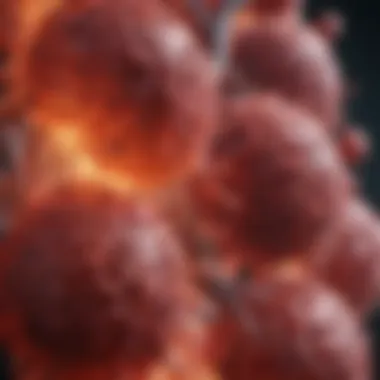

Inflammatory cells are essential for signaling the transition from inflammation to healing. They facilitate tissue regeneration by secreting various factors that stimulate cell proliferation and tissue remodeling. The presence of these cells is not merely coincidental; instead, they actively participate in the restoration of tissue architecture and function.
Factors such as cytokines and growth factors released by cells, including macrophages and fibroblasts, trigger several biological responses that culminate in healing. They coordinate a plethora of events, which include angiogenesis, extracellular matrix formation, and cell migration towards the injury site.
"Inflammatory cells are pivotal for initiating the repair process and creating an environment conducive to healing."
Mediators of Healing
Mediators of healing include signaling molecules and cells that promote recovery. Cytokines, like interleukin-10 and transforming growth factor-beta, help regulate inflammation and cell migration. Other important mediators include growth factors like vascular endothelial growth factor and platelet-derived growth factor.
These factors work by:
- Stimulating cell proliferation: This is essential for replacing damaged or dead cells.
- Promoting angiogenesis: Formation of new blood vessels is necessary for supplying nutrients and oxygen to healing tissue.
- Regulating matrix deposition: The extracellular matrix provides structural support to tissues and is crucial during repair processes.
The interplay of these mediators creates a harmony that tilts toward tissue regeneration rather than ongoing inflammation or fibrosis.
Transition from Inflammation to Repair
The transition from inflammation to repair represents a critical point in the healing process. Initially, inflammatory cells increase at the site of injury, releasing pro-inflammatory cytokines. This stage, while necessary, must be carefully regulated to prevent chronic inflammation.
As the need for inflammation decreases, signaling molecules shift towards pro-repair pathways. Key cellular transitions involve:
- Macrophages switching phenotypes: From inflammatory (M1) to reparative (M2), which promote healing and tissue remodeling.
- Fibroblasts becoming activated: They help produce collagen and extracellular matrix components crucial for tissue integrity.
Maintaining a balance during the transition is essential. Failure to do so can result in inadequate repair or excessive scar formation, which impacts organ function. Understanding these transitions can help in modifying treatments for better outcomes in wound healing and recovery.
Future Directions in Inflammatory Cell Research
Understanding the role of inflammatory cells in both health and disease is a key aspect of modern biomedical research. The field is evolving as scientists seek novel insights to enhance therapeutic strategies, which can lead to improved outcomes in various inflammatory and autoimmune diseases. Future directions in this area promise to transform how we approach treatment and management of these conditions.
Novel Therapeutic Approaches
Recent advancements in techniques such as single-cell sequencing and advanced imaging are paving the way for the development of targeted therapies.
- Biologics: Agents that can specifically target inflammatory pathways are becoming increasingly significant. For example, monoclonal antibodies that inhibit tumor necrosis factor (TNF) have shown effectiveness in several chronic inflammatory disorders, including rheumatoid arthritis and Crohn’s disease.
- Small Molecule Inhibitors: These compounds are designed to interfere with specific signaling pathways in inflammatory cells. Joint influences of various pathways are being studied to find beneficial combinations that may enhance the efficacy of traditional therapies.
- Cell Therapy: This encompasses strategies like using regulatory T cells to moderate inflammation. The goal is to restore balance in the immune response, thus promoting tissue repair without excess damage.
Innovations will likely focus on personalized medicine, where therapies are tailored to an individual’s unique inflammatory profile based on genetic makeup and disease characteristics. This precision approach offers the potential to significantly improve patient outcomes.
Understanding the Microbiome's Influence
The human microbiome has emerged as a crucial factor in regulating inflammatory responses. Research is increasingly focusing on how microbial communities affect immune cell behavior and inflammatory processes.
- Gut Microbiota: Certain gut bacteria can influence systemic inflammation and modulate the function of inflammatory cells. This has implications for diseases such as inflammatory bowel disease and metabolic syndrome.
- Dysbiosis: An imbalance in the microbiome can lead to chronic inflammation and autoimmune conditions. Understanding these changes is critical for developing strategies to restore healthy microbiome diversity, thus potentially mitigating inflammation.
- Probiotics and Prebiotics: These interventions are being explored for their ability to positively alter the microbiome and promote a balanced inflammatory response. The goal is to use these agents to enhance health and prevent disease.
In summary, deciphering the intricate relationship between inflammatory cells and the microbiome not only has implications for therapeutic advances but also adds a layer of complexity to our understanding of health and disease.
By investing in the exploration of these future directions, we can foster groundbreaking discoveries that will ultimately lead to effective treatments and improved quality of life for individuals affected by inflammatory diseases.
Ending
In the context of our exploration of inflammatory cells, it is essential to recognize their pivotal roles in both disease and tissue repair. The implications of understanding this duality extend beyond mere academic interest; they are foundational to advancements in medical science and therapeutics. Recognizing how these cells operate in various conditions—both beneficially and detrimental—can shape the strategies for treatment in numerous health conditions.
Summarizing the Dual Role of Inflammatory Cells
Inflammatory cells serve as a double-edged sword. On one hand, they are crucial for initiating and sustaining the body's immune response. Their activation is essential for fighting infections and beginning the healing process after injuries. Neutrophils, macrophages, and lymphocytes are key players in this regard. These cells respond quickly to injury or infection, releasing cytokines and chemokines that orchestrate the immune response.
On the other hand, chronic inflammation can lead to significant tissue damage and diseases such as rheumatoid arthritis, cardiovascular diseases, and cancer. For instance, in cases of autoimmune disorders, inflammatory cells may mistakenly target the body's tissues, leading to chronic pain and dysfunction.
A succinct understanding of these roles involves acknowledging both their protective functions and their potential to contribute to pathology. This duality emphasizes the importance of targeted therapeutic approaches. Treatments designed to modulate inflammatory responses, such as monoclonal antibodies in rheumatoid arthritis or checkpoint inhibitors in cancer immunotherapy, are rooted in this nuanced comprehension.
In recognizing the complex roles of inflammatory cells, one gains insight into potential therapeutic avenues for a variety of diseases.



